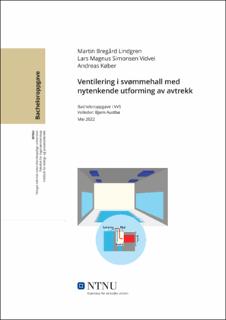| dc.contributor.advisor | Austbø, Bjørn | |
| dc.contributor.advisor | Aas, Bjørn | |
| dc.contributor.author | Lindgren, Martin Bregård | |
| dc.contributor.author | Køber, Andreas | |
| dc.contributor.author | Vidvei, Lars Magnus Simonsen | |
| dc.date.accessioned | 2022-07-08T17:21:43Z | |
| dc.date.available | 2022-07-08T17:21:43Z | |
| dc.date.issued | 2022 | |
| dc.identifier | no.ntnu:inspera:112168122:112168344 | |
| dc.identifier.uri | https://hdl.handle.net/11250/3004221 | |
| dc.description.abstract | I denne oppgaven blir utfordringene ved å ventilere svømmehaller drøftet. Det blir presentert og diskutert en mulig løsning for å forbedre ventilering, folkehelse og inneklimaet i svømmehaller. Gjennom litteraturstudier, målinger og utregninger blir det drøftet hvordan ventilering i en svømmehall er utformet samt hvordan denne kan forbedres.
Dagens løsning tilfredsstiller akseptable $CO_2$- og luftfuktighetsnivåer, samtidig som den forhindrer fukt på utsatte områder. Ventilasjonsløsninger, som bygges i dag, baserer seg ofte på Byggforsk standarden for ventilering av svømmehaller. Denne Byggforskserien ble skrevet i 2003. Oppgaven argumenterer for at strengere krav til varmegjennomgangstall i bygningskonstruksjonen åpner muligheten for å endre ventilasjonsprinsipp til et mer effektivt prinsipp som ivaretar folkehelsen bedre, samtidig med at bygningskonstruksjonen blir beskyttet mot fukt.
Nyere forskning viser en korrelasjon mellom astma og personer som bruker mye tid i svømmehaller. I andre prosesser der det er tilfeller hvor det oppstår farlige gasser blir gassene trukket av ved forurensningskilden. Siden den største forurensningskilden til farlige gasser i en svømmehall er langs vannoverflaten, er det i denne oppgaven utviklet et avtrekkssystem i overløpsrennen. | |
| dc.description.abstract | This thesis will discuss the challenges of ventilating swimming pools and a possible solution to improve ventilation, public health, and the indoor climate regarding swimming pools. Through literature studies, measurements and calculations, it has been examined how the ventilation in a swimming pool is designed and how it can be improved. Today, the supply air is recommended to be supplied along the row of windows as this has been an exposed area for moisture due to high heat transfer rates. With stricter energy requirements, the heat transfer rate has improved, and therefore, other options for supplying the air in the room should be turned on.
Today’s solution satisfies current requirment with respect to $CO_2$ and humidity levels, while preventing moisture in exposed areas. Current ventilation solutions are based on the Byggforsk's standard (building code) for swimming pools which was published in 2003. This thesis argues that due to stricter energy requirements for heat transfer figures on the building structure, it is time to change how swimming pools are ventilated.
Recent research shows a correlation between asthma and people who spend a lot of time in swimming pools. In other cases where harmful gases occur, the air is drawn off from the source of pollution. Since the most extensive inception of decay to hazardous gases in a swimming pool is along the water surface, an exhaust system has been developed for this task in the overflow gutter. | |
| dc.language | nob | |
| dc.publisher | NTNU | |
| dc.title | Ventilering i svømmehall med nytenkende utforming av avtrekk | |
| dc.type | Bachelor thesis | |
